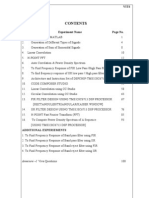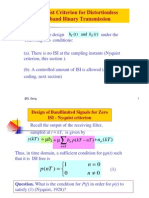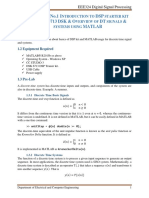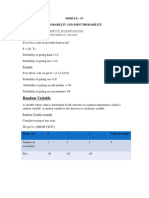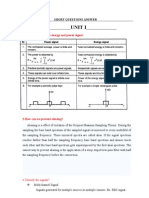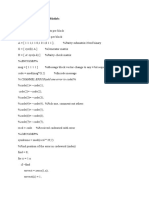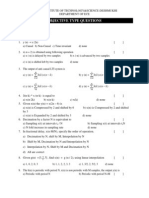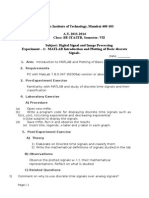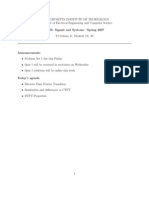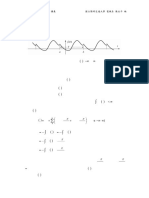100%(1)100% found this document useful (1 vote)
5K viewsMatlab Program For Circular Convolution Property of DFT
The Matlab program demonstrates the circular convolution property of the discrete Fourier transform (DFT) by directly calculating the convolution of two signals x and h, and comparing it to the result of taking the DFT of each signal and multiplying the results. The program defines the signals x and h, pads each with zeros to length N1+N2-1, directly calculates the convolution y, takes the DFT of x and h and multiplies them, and plots the results of the direct convolution and DFT multiplication to show they are equal, demonstrating the circular convolution property.
Uploaded by
Angelyn PhilipCopyright
© Attribution Non-Commercial (BY-NC)
Available Formats
Download as DOC, PDF, TXT or read online on Scribd
100%(1)100% found this document useful (1 vote)
5K viewsMatlab Program For Circular Convolution Property of DFT
The Matlab program demonstrates the circular convolution property of the discrete Fourier transform (DFT) by directly calculating the convolution of two signals x and h, and comparing it to the result of taking the DFT of each signal and multiplying the results. The program defines the signals x and h, pads each with zeros to length N1+N2-1, directly calculates the convolution y, takes the DFT of x and h and multiplies them, and plots the results of the direct convolution and DFT multiplication to show they are equal, demonstrating the circular convolution property.
Uploaded by
Angelyn PhilipCopyright
© Attribution Non-Commercial (BY-NC)
Available Formats
Download as DOC, PDF, TXT or read online on Scribd
You are on page 1/ 2
Matlab program for circular convolution property of dft:x=[1,2,3,4]; %first signal
h=[3,6,9,5]; %second signal
N1=length(x);
N2=length(h);
X=[x,zeros(1,N2)];% padding of N2 zeros
H=[h,zeros(1,N1)];% padding of N1 zeros
for i=1:N1+N2-1
y(i)=0;
for j=1:N1
if(i-j+1>0)
y(i)=y(i)+X(j)*H(i-j+1);
else
end
end
end
n=N1+N2-1;
X1=fft(x,n);
X2=fft(h,n);
X=X1.*X2;
subplot(211);
stem(abs(X));
title('Answer using DFT method');
Y=fft(y,n);
subplot(212);
stem(abs(Y));
title('Answer using direct convelution');
Output:-
You might also like
- Matlab Code For Basic DSP Signals MATLAB PROGRAM TO DISPLAY THE PROPERTIES OF DISCRETE FOURIER TRANSFORM (DFT)No ratings yetMatlab Code For Basic DSP Signals MATLAB PROGRAM TO DISPLAY THE PROPERTIES OF DISCRETE FOURIER TRANSFORM (DFT)16 pages
- MATLAB Code Gauss Eliminations Method: % Forward EliminationNo ratings yetMATLAB Code Gauss Eliminations Method: % Forward Elimination3 pages
- To Design and Implement An FIR Filter For Given Specifications100% (1)To Design and Implement An FIR Filter For Given Specifications8 pages
- VLSI Signal Processing Basics and Iteration Bound K.K. Parhi100% (1)VLSI Signal Processing Basics and Iteration Bound K.K. Parhi49 pages
- Experiment No.1 I DSP TMS320C6713 DSK & O DT & Matlab: Lab Manual EEE324 Digital Signal ProcessingNo ratings yetExperiment No.1 I DSP TMS320C6713 DSK & O DT & Matlab: Lab Manual EEE324 Digital Signal Processing14 pages
- ISI & Nyquist Criterion For Distortion Less Baseband Binary Data Transmission0% (1)ISI & Nyquist Criterion For Distortion Less Baseband Binary Data Transmission7 pages
- Lab Report 6: Digital System and ProcessingNo ratings yetLab Report 6: Digital System and Processing8 pages
- Write A Mat Lab Program To Perform Linear and Circular Convolution of The Discrete Time Sequences X50% (2)Write A Mat Lab Program To Perform Linear and Circular Convolution of The Discrete Time Sequences X26 pages
- 227 39 Solutions Instructor Manual Chapter 1 Signals Systems100% (4)227 39 Solutions Instructor Manual Chapter 1 Signals Systems18 pages
- System Software Lab Manual: (Lex Programs)No ratings yetSystem Software Lab Manual: (Lex Programs)22 pages
- Matlab Code For Implementation of Routh Harwitz Table100% (1)Matlab Code For Implementation of Routh Harwitz Table4 pages
- Linear Convolution Program in C Language Using CCStudio80% (5)Linear Convolution Program in C Language Using CCStudio3 pages
- To Evaluate Given Integral Using Dirac Delta Function ScilabNo ratings yetTo Evaluate Given Integral Using Dirac Delta Function Scilab2 pages
- Frequency Modulation and Demodultion (FM) : All AllNo ratings yetFrequency Modulation and Demodultion (FM) : All All2 pages
- Lab # 1 Introduction To Communications Principles Using MatlabNo ratings yetLab # 1 Introduction To Communications Principles Using Matlab22 pages
- Questions On DFT Efficient Computation - Fast Fourier Transform Algorithms100% (1)Questions On DFT Efficient Computation - Fast Fourier Transform Algorithms22 pages
- Signals and Systems Lab 3: Convolution Discrete Time ConvolutionNo ratings yetSignals and Systems Lab 3: Convolution Discrete Time Convolution14 pages
- %program For Computing Convolution and M-Fold Decimation by Polyphase DecompositionNo ratings yet%program For Computing Convolution and M-Fold Decimation by Polyphase Decomposition1 page
- Fourier Amplitude Spectrum Theory and Examples: Dr. Sukumar Baishya Civil Engineering DepartmentNo ratings yetFourier Amplitude Spectrum Theory and Examples: Dr. Sukumar Baishya Civil Engineering Department25 pages
- Matlab Assignment: Submitted By:-Siddhant Raut (6464)No ratings yetMatlab Assignment: Submitted By:-Siddhant Raut (6464)3 pages
- Fourier Series MP Career Endeavour NotesNo ratings yetFourier Series MP Career Endeavour Notes9 pages
- All Hardware: % DSP - Sinewave (Amp, Freq, Phase, Name, Value)No ratings yetAll Hardware: % DSP - Sinewave (Amp, Freq, Phase, Name, Value)13 pages
- Course No Course Title Instructor-In-ChargeNo ratings yetCourse No Course Title Instructor-In-Charge3 pages
- Digital Signal and Image Processing 1st Edition Tamal Bose - Get the ebook in PDF format for a complete experienceNo ratings yetDigital Signal and Image Processing 1st Edition Tamal Bose - Get the ebook in PDF format for a complete experience80 pages
- Math 3D Laplace Transform Cheat Sheet (Spring 2017)No ratings yetMath 3D Laplace Transform Cheat Sheet (Spring 2017)1 page
- Rajshahi University of Engineering & TechnologyNo ratings yetRajshahi University of Engineering & Technology4 pages
- Principles of Linear Systems and Signals - B. P. Lathi PDF75% (4)Principles of Linear Systems and Signals - B. P. Lathi PDF140 pages






